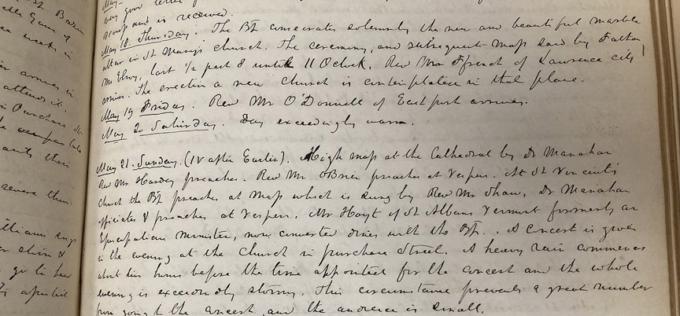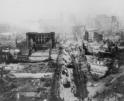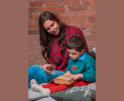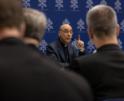
Culture
As early as 1842, William Hoyt confided to his diary that he was actively attempting to spread "my own high Catholic views of the Church itself and its ministry of the Sacraments."
On May 21, 1848 -- 175 years ago next week -- Bishop John Bernard Fitzpatrick dined with William Henry Hoyt, a former Episcopal minister who had recently converted to Catholicism.
William Henry Hoyt was born in Sandwich, New Hampshire, on Jan. 8, 1813. The son of Sally (Flanders) Hoyt and General Daniel Hoyt, William Hoyt was raised in a family of unimpeachable Yankee credentials. His grandfather, Joseph Hoyt (Hoit) was a lieutenant of the First New Hampshire Regiment, which saw action in the Battle of Bunker Hill. His father Daniel Hoyt was active in the state militia, rising from lieutenant colonel to brigadier general. From 1808 to 1822, his father also served as selectman of Sandwich, New Hampshire, where he owned a successful general store. Eventually, Daniel Hoyt became a state senator, and he ran several times for governor.
Needless to say, given his family's prominence in the early 19th century, William Hoyt was raised Protestant. He attended Dartmouth College, where he graduated with the Class of 1831.
Feeling a call to ordained ministry, he attended Andover Theological Seminary in Massachusetts, intending to become a Congregational minister; however, early in his studies, he converted to the Episcopal Church, leaving Andover for the General Theological Seminary in New York. He was ordained an Episcopal deacon in 1837 and served as rector of St. Luke's Church in St. Albans, Vermont, from 1838 until 1846.
Within a few short years, William Hoyt rose to a position of surprising influence within the Episcopal Diocese of Vermont. He served as a trustee of the General Theological Seminary, secretary to the Diocesan Conventions, and in 1844, he was a delegate to the National Episcopal Convention. He was a mentee of and friend to his bishop, John Henry Hopkins, who wrote that he was "perhaps the most prominent and influential presbyter in the diocese."
The cordial relationship between William Hoyt and his bishop began to unravel when, in the early 1840s, Hoyt became swept up in what is now known as the Oxford Movement. The Oxford Movement, which called for the reinstatement of some older Christian traditions of faith and their inclusion into Anglican and Episcopal liturgy and theology, was spearheaded by John Henry Newman and Edward Bouverie Pusey. It considered Anglicanism to be a branch of the "one, holy, catholic, and apostolic" Christian church, and many of its adherents later converted to Catholicism.
As early as 1842, William Hoyt confided to his diary that he was actively attempting to spread "my own high Catholic views of the Church itself and its ministry of the Sacraments." He introduced Gregorian chant at St. Luke's, and increased the frequency with which the Eucharist, which he called "the Eucharistic sacrifice," was offered at that church.
A year later, Bishop Hopkins felt compelled to respond to the actions of William Hoyt and other Episcopal ministers who had taken to the Oxford Movement. His "Letters on the Novelties that Disturb Our Peace" was a sharp rebuke of the movement, which he felt had gone too far. He wrote privately to Hoyt that he was disturbed by his "Romish tendencies." Yet, Hoyt could not be dissuaded from his new beliefs. Instead, he entered into correspondence with dozens of prominent Catholics, including converts like Orestes Brownson and high-ranking clergy, including Archbishop John McCloskey of New York.
As he formed relationships with Catholics and learned more about the Church and her tradition, he became convinced that he needed to leave the Episcopal Church. On July 24, 1846, he presented his resignation to Bishop Hopkins, and two days later, he was received into the Catholic Church in Montreal. Of the joyful occasion, he wrote in his diary, "I received the Holy Sacrament -- and for the first time. May I ever gratefully and devoutly remember it, and also the events of yesterday. I am a Catholic, God be thanked!"
For 29 years after his conversion, William Hoyt lived as a layman. For years, he attended the Catholic Church in St. Albans, sitting in the pews down the street from where he had once preached from the pulpit. He went to law school and practiced law first in Burlington and then in New York. He raised three children with his wife, Anne (Deming).
When Anne died in 1875, William Hoyt once again felt the call that had risen in him as a young man -- to be ordained and to place himself at the service of his Church. He entered Seton Hall Seminary and was ordained in 1877. The last six years of his life were spent as a priest, chiefly in New York City. On the feast of the Immaculate Conception, Dec. 8, 1883, Father William Hoyt collapsed to the floor while celebrating Mass at St. Anne's Church. He never regained consciousness and died three days later. As Father Robert H. Lord wrote in the "History of the Archdiocese of Boston," "A beautiful life was crowned by a beautiful death."
VIOLET HURST IS AN ARCHIVIST FOR THE ARCHDIOCESE OF BOSTON.
Recent articles in the Culture & Events section
-
Boston and the nation respond to the San Francisco Earthquake of 1906Thomas Lester
-
See you in the storyLaura Kelly Fanucci
-
'Dignitas' and the mediaRussell Shaw
-
Scripture Reflection for April 14, 2024, Third Sunday of EasterDeacon Greg Kandra
-
St. Helena's House is established in the South EndThomas Lester


















